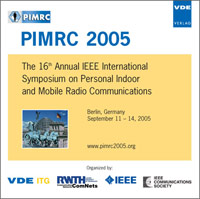Impact of Iub Flow Control on HSDPA System Performance
Conference: PIMRC 2005 - 16th Annual IEEE International Symposium on Personal Indoor and Mobile Radio Communications
09/11/2005 - 09/14/2005 at Berlin, Germany
Proceedings: PIMRC 2005
Pages: 5Language: englishTyp: PDF
Personal VDE Members are entitled to a 10% discount on this title
Authors:
Necker, Marc C. (Institute of Communication Networks and Computer Engineering, University of Stuttgart, Pfaffenwaldring 47, 70569 Stuttgart, Germany)
Weber, Andreas (Alcatel SEL AG, Research and Innovation, Lorenzstr. 10, 70435 Stuttgart, Germany)
Abstract:
The recently emerging High Speed Downlink Packet Access (HSDPA) enhances conventional WCDMA systems according to the UMTS standard with data rates of up to 14MBit/s in the downlink direction. This is achieved by using adaptive modulation and coding as well as a fast Hybrid Automatic Repeat Request (HARQ) mechanism. This functionality is implemented close to the air interface in the Node B. In addition to the data buffer in the RNC, this requires a second data buffer in the Node B. Consequently, a flow control mechanism is needed which controls the amount of data to be transmitted from the RNC's buffer to the Node B's buffer. The spatial separation of RNC and Node B imposes significant signaling constraints and control dead time limitations to the flow control mechanism. Additionally, due to the time-varying nature of the radio channel, the data rate towards a particular user may be highly variable. In this paper, we study the impact of the flow control on system performance. We will show that it is essential to jointly consider scheduling and flow control in an HSDPA system as the constraints imposed by the flow control may dominate the system performance.


